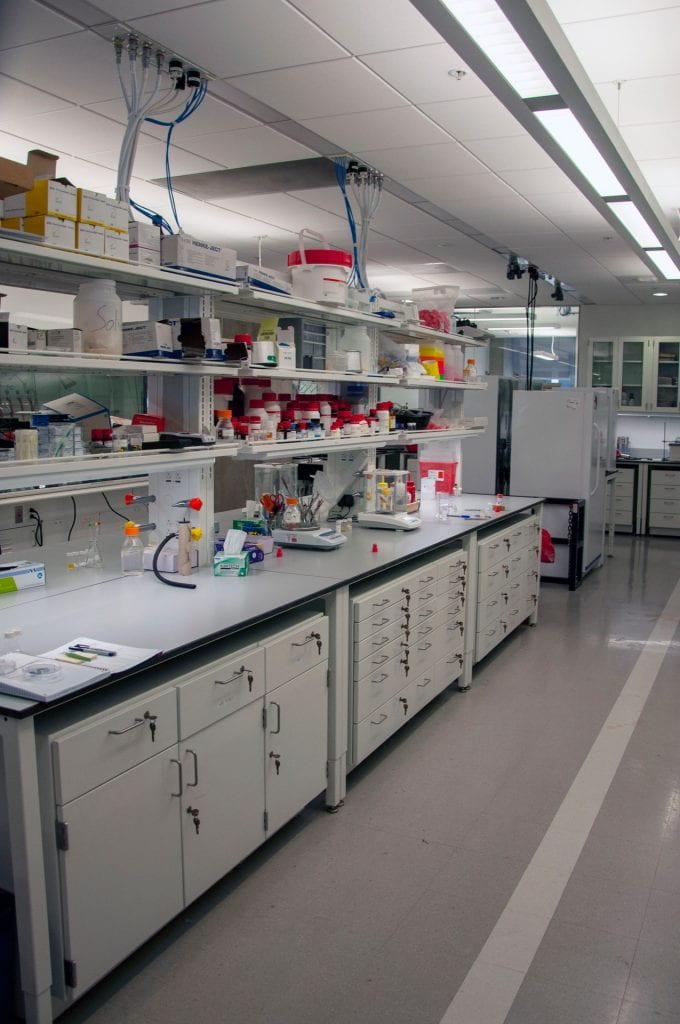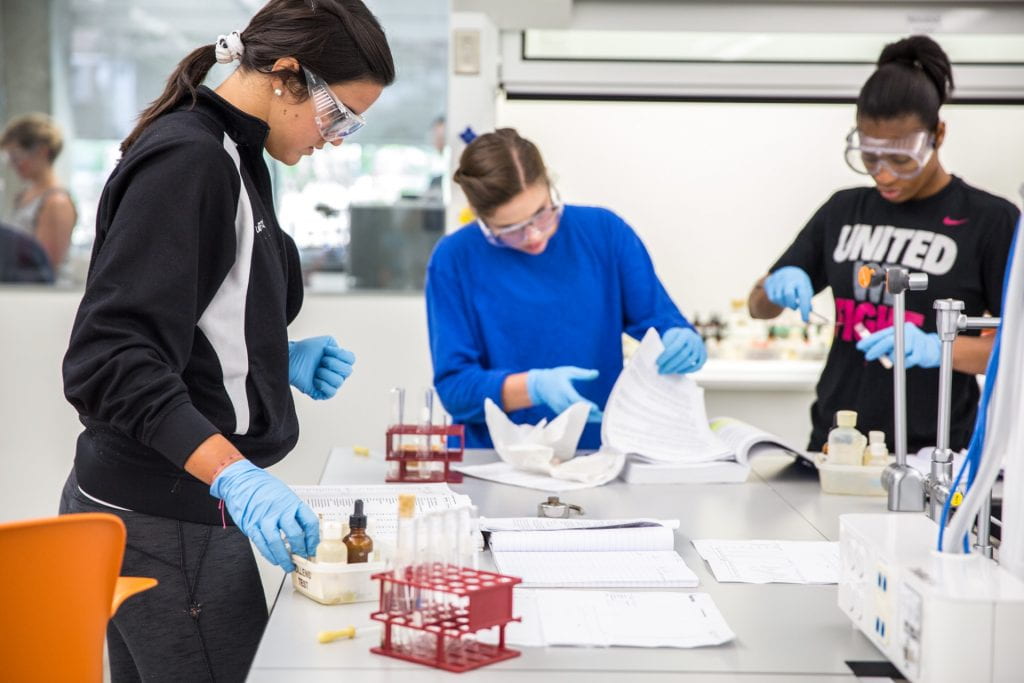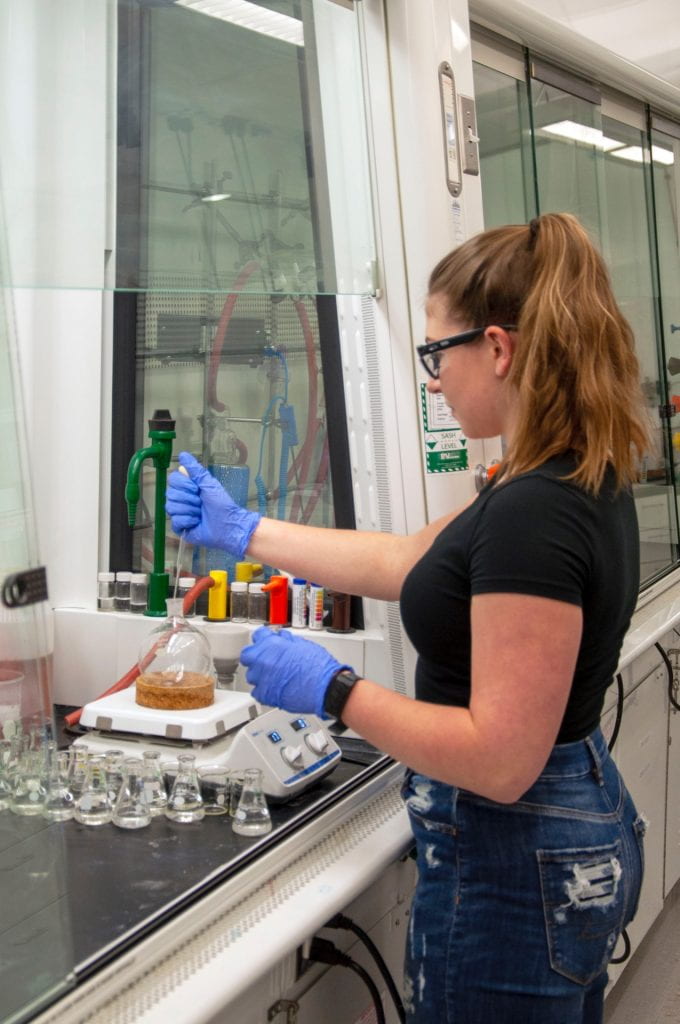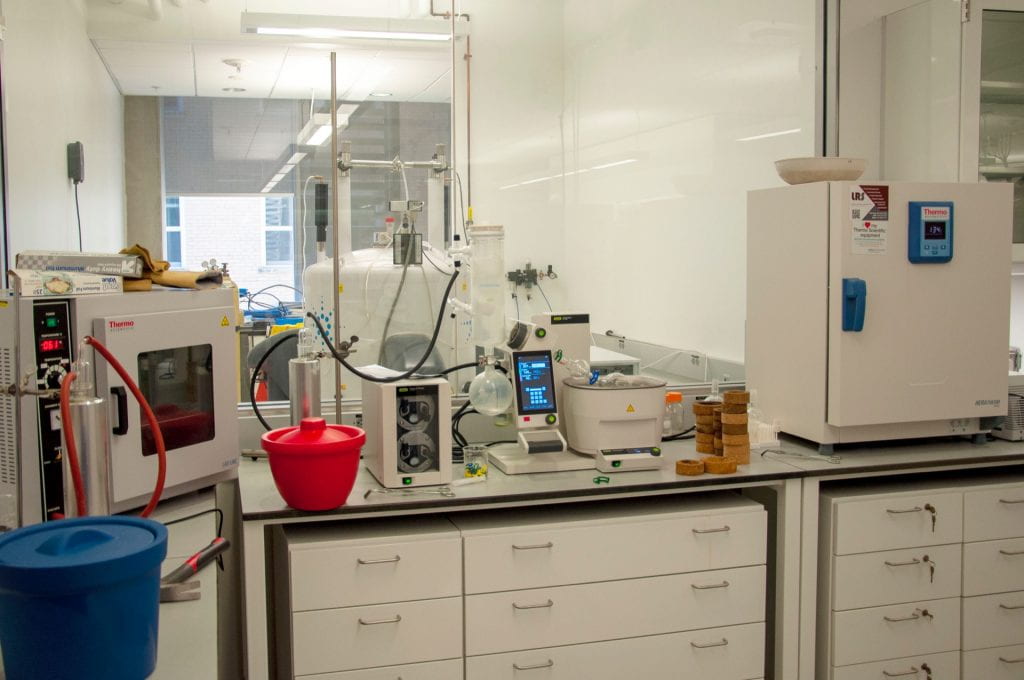Each year of the program faculty members from the GW chemistry department and their collaborators will offer research projects that cover a broad range of topics centered around green chemistry, environmental chemistry, and sustainability.
The following are titles of some of the projects that will be offered in the Summer of 2024. More details about each of the projects can be found below. If you would like more information about any of the projects, please reach out to the faculty participant. Other projects will be offered and the list will be updated as the descriptions become available.
Project Titles
High Performance Polymer Coatings for Reverse Osmosis Membranes (Boyes)
Development of Mass Spectrometry-based Bioanalytical Chemistry Methods to Study Human Neurons and Neurodegeneration (Hao)
Harnessing Noncovalent Interactions for the Assembly of Low Dimensional Metal Halides: Tuning Structure and Electronic Properties (Cahill)
Design and Synthesis of Novel Antibiotics to Combat Malaria and Tuberculosis (Dowd)
Protein Engineering to Design a Better Enzyme (Massiah)
Vertical and Horizontal Profile Measurements of Greenhouse Gases (Miller)
Biomimetic Molecular Scaffold Design for Protein Surface Recognition (Meisel)
Project Descriptions
High Performance Polymer Coatings for Reverse Osmosis Membranes
Faculty Participant:
Project Description:
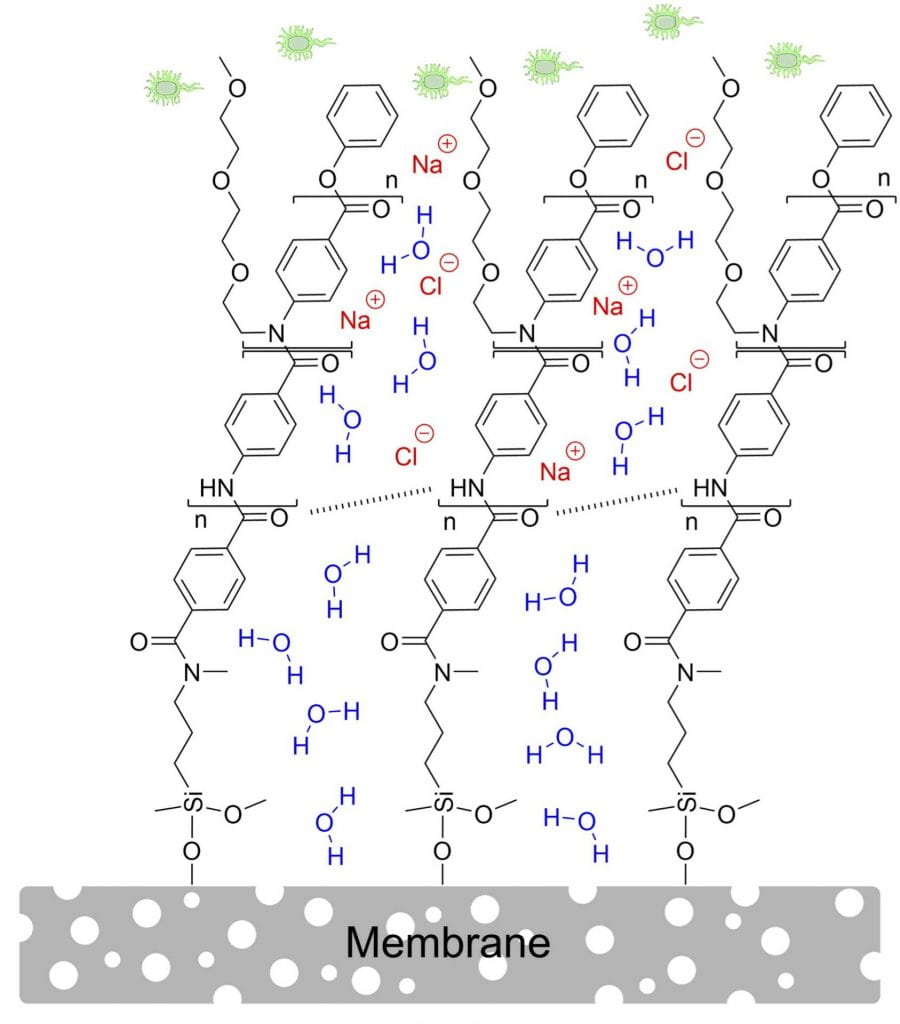
Recently researchers have established a need to develop polymer brushes based on aromatic polymers for application in areas such as tribological coatings, reverse osmosis (RO) membranes, and biosensing. In this project, the REU participant will expand on exciting preliminary work and conduct a study into the use of substituent effect chain growth polycondensation for the preparation of aromatic polyamide brushes to develop an improved understanding of the factors influencing brush growth, structure, and functionality, in addition to demonstrating the application of these systems in membranes for RO. The goal of this project is to develop new polymer coatings to improve the stability and performance of RO membranes for water purification (NSF: 180786). To achieve this goal, the REU participant will explore a combination of experimental and computational (with collaborators) methods to predict the effect of monomer structure on polymerization performance.
- Reese, C.J.; Qi, Y.; Abele, D.T.; Wagner, M.J.; Liu, X.; Boyes, S.G. Antifouling Oligoethylene Glycol-Functionalized Aromatic Polyamide Brushes Synthesized via Surface-Initiated Chain-Growth Condensation Polymerization. ACS Appl. Polym. Mater. 2022, 4, 1890 – 1902. https://pubs.acs.org/doi/full/10.1021/acsapm.1c01742
- Reese, C.J.; Qi, Y.; Abele, D.T.; Shlafstein, M.D.; Wagner, M.J.; Liu, X.; Boyes, S.G. Aromatic Polyamide Brushes for High Young’s Modulus Surfaces by Surface-Initiated Chain-Growth Condensation Polymerization. Macromolecules 2022, 55, 2051 – 2066. https://pubs.acs.org/doi/full/10.1021/acs.macromol.1c02088
Development of Mass Spectrometry-based Bioanalytical Chemistry Methods to Study Human Neurons and Neurodegeneration
Faculty Participant:
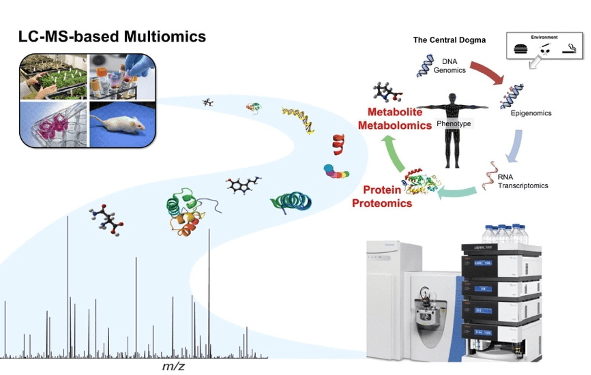
Quantitative analysis of biomolecules offers a wealth of clues to understand cell biology and disease mechanisms. Mass spectrometry (MS) has become a central technology to study biomolecules such as proteins, peptides, lipids, and small molecule metabolites. Our research focuses on developing novel and improved bioanalytical methods using LC-MS platforms and applying the combination of analytical chemistry, bioinformatics, and cell biology approaches to study the human brain. Neurodegenerative diseases, such as Alzheimer’s disease and Parkinson’s disease, affect millions of people worldwide. Unfortunately, currently there is no cure for most of brain diseases due to our limited understanding of the central nervous system. The goal of this project is to develop novel analytical methodologies to improve the quantification and identification of endogenous molecules in human neurons and apply these methodologies to study neurodegeneration. The REU student will participate in developing and applying the LC-MS-based methods to study stem cell-derived neurons as a cellular model to study neurodegeneration. We will teach the REU student how to harvest different molecules from neurons, and prepare these samples for LC-MS analysis, as well as sophisticated Omics data analysis.
- Frankenfield, A.; Ni, J.; Hao, L. Characterization of Neuronal Lysosome Interactome with Proximity Labeling Proteomics. Journal of Visualized Experiments 2022, 184, e64132 https://www.jove.com/t/64132/characterization-neuronal-lysosome-interactome-with-proximity
- Li, H.; Uittenbogaard, M.; Navarro, R.; Ahmed, M.; Gropman, A.; Chiaramello, A.; Hao, L. Integrated Proteomic and Metabolomic Analyses of the Mitochondrial Neurodegenerative Disease MELAS. Molecular Omics 2022, 18, 196-205 https://pubs.rsc.org/en/content/articlelanding/2022/mo/d1mo00416f/unauth
- Frankenfield, A.; Ni, J.; Ahmed, M.; Hao, L. Protein Contaminants Matter: Building Universal Protein Contaminant Libraries for DDA & DIA Proteomics. 2022, 21, 9, 2104-2113 https://pubs.acs.org/doi/10.1021/acs.jproteome.2c00145
Harnessing Noncovalent Interactions for the Assembly of Low Dimensional Metal Halides: Tuning Structure and Electronic Properties
Faculty Participant:
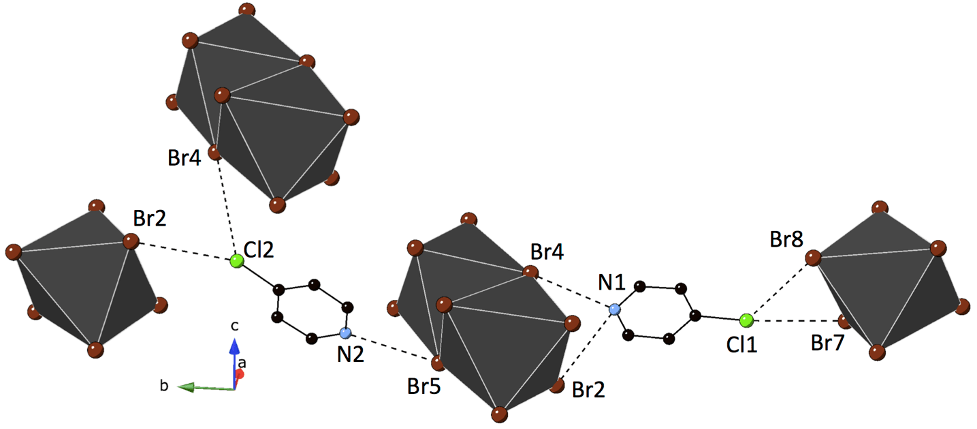
Significant efforts are underway toward the development of next generation inorganic and hybrid photovoltaic materials for use in solar cells and semiconductors. Of these, perovskites and their derivatives have garnered the most attention, owing to their efficient power conversion, tunable band gaps, high absorption coefficients, and low production costs. Lead halide perovskites are particularly attractive, with reported power conversion efficiency upwards of 22.1%. Challenges remain, however, owing to lead toxicity and the inherent instability of three-dimensional halide based structures. Efforts in the Cahill group explore alternative compositions based on Sb, In and Te-halides prepared via self-assembly under ambient conditions. Opportunities for students include the synthesis of novel metal-halide based compositions, structure determination thereof using single crystal X-ray diffraction, and optical spectroscopy interrogation to develop structure-property relationships. The figure above highlights the structure of (C5H5NCl)[SbBr4] highlighting halogen and hydrogen bonding between chains of [SbBr6]3- anions and 4-chloropyridinium cations. Such non-covalent interactions contribute to assembly and influence electronic structure.
Design and Synthesis of Novel Antibiotics to Combat Malaria and Tuberculosis
Faculty Participant:
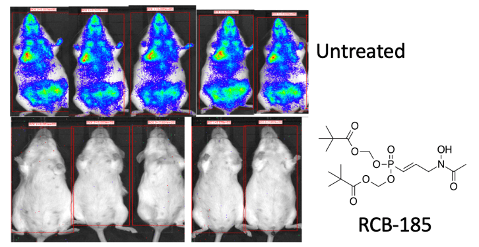
Despite a resurgence of research productivity over the last decade by academic and pharmaceutical groups alike, human pathogens continue to plague the global community. Drug resistance (when a pathogen is no longer affected by a clinically used medicine), is on the rise and demands that we develop new medicines against these concerning bugs. Research in the Dowd lab is focused on using tools such as organic synthesis and medicinal chemistry to design and synthesize new small molecules that will be effective against Plasmodium falciparum, the major causative agent of malaria, and Mycobacterium tuberculosis, causing tuberculosis. Building on the work of prior students in the lab, we continue to make new small molecules against our primary target, Dxr/IspC, which is an essential process in making 5-carbon units for the cell. Our compounds are phosphonate prodrug esters and have already been shown to be very active against P. falciparum and M. tuberculosis. REU students will learn how to synthesize these molecules, developing skills in organic reaction setup, compound purification, and product characterization by LCMS and NMR.
- Heidel, K.M.; Dowd, C.S. Phosphonate prodrugs: an overview and recent advances, Future Medicinal Chemistry, 2019, 11(13), 1625-1643. PMID: 31469328 https://www.future-science.com/doi/10.4155/fmc-2018-0591
- Wang, X.; Edwards, R.L.; Ball, Hl; Johnson, C.; Haymond, A.; Girma, M.; Manikkam, M.; Brothers, R.C.; McKay, K.T.; Arnett, S.D.; Osbourn, D.M.; Alvarez, S.; Boshoff, H.I.; Meyers, M.J.; Couch, R.D.; Odom John, A.R.; Dowd, C.S. MEPicides: α,β-Unsaturated Fosmidomycin Analogs as DXR inhibitors against Malaria, J. Med. Chem., 2018, 61(19),8847–8858. PMID: 30192536 https://pubs.acs.org/doi/10.1021/acs.jmedchem.8b01026
- Wang, X.; Dowd, C.S.* The MEP pathway: Promising drug targets in the fight against tuberculosis, ACS Infectious Diseases, 2018, 4(3), 278-290. PMID: 29390176 https://pubs.acs.org/doi/full/10.1021/acsinfecdis.7b00176
Protein Engineering to Design a Better Enzyme
Faculty Participant:
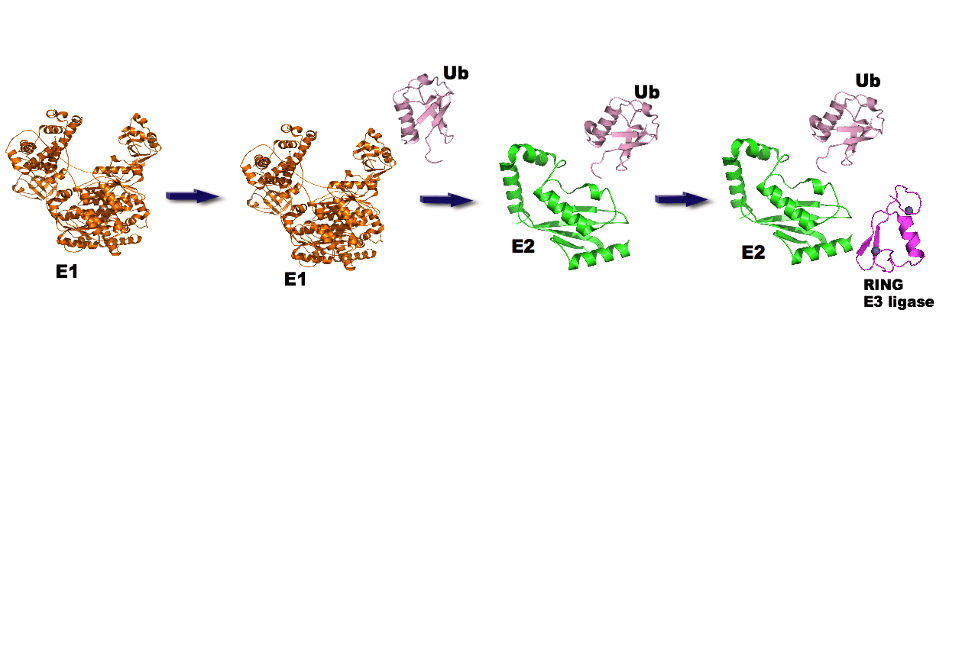
In cells, proteins are produced in a timely matter, allow to perform tasks, and are then recycled as a mean to regulate its function, concentration and the overall specific cellular process. Proteins covalently tagged with the ubiquitin proteins (ubiquitination) are normally recruited to the proteasome, which then releases the ubiquitin but cleaves the target protein into smaller peptides. Three classes of proteins are involved in ubiquitination and the RING E3 class is responsible for directing substrate specificity. Our lab studies a protein that has a similar structure as RING E3 ligases but which only exhibits a very weak RING ligase activity. Through several mutations we are successful in creating proteins that have significantly greater activities than the original. In doing so, we also learn about the mechanism of function of RING ligases. Students joining my lab for the summer will have the opportunity to use PCR to introduce at least one additional mutation, use bacteria to over-produce the protein, and employ several analytical techniques, including our own 600 NMR spectrometer, to characterize the function, structure, and binding interactions of their mutant protein. Successful completion or significant contribution to this project will result in co-authorship in a manuscript presenting research findings.
Vertical and Horizontal Profile Measurements of Greenhouse Gases
Faculty Participant:
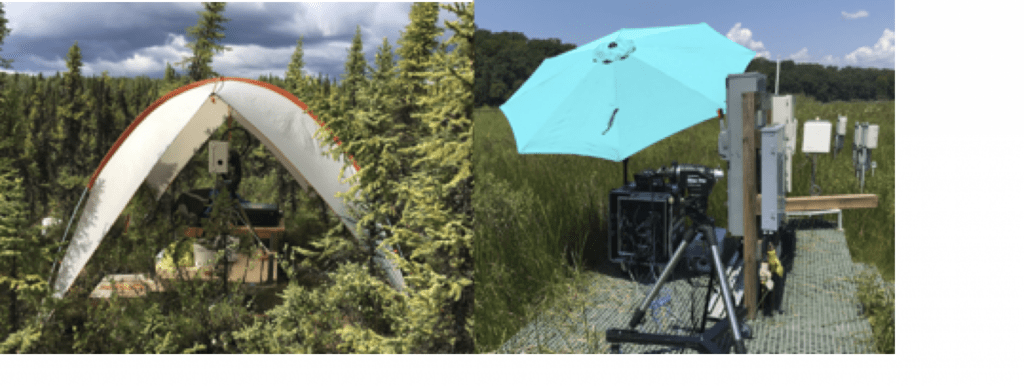
Our lab is supported by the Department of Energy to develop greenhouse gas sensors for application in assessing their role in atmospheric radiation transfer. (i.e., sources and sinks in global warming.) Two instruments are being deployed at the Smithsonian Environmental Research Center that will work in tandem to measure the path-averaged concentrations along a horizontal path and upwards-looking (vertical) paths to measure both near-surface sources and atmospheric mixing. (See Appl. Phys. B 123, 245 (2017) and Appl. Opt. 59(7), B10–B17 (2020) for descriptions of the instruments. Both instruments will be housed in a robotic observatory dome at the Global Change Research Wetland (https://serc.si.edu/gcrew) beginning in the first quarter of 2022 with a near-continuous data stream commencing before summer 2022. An REU student will participate in continuing aspects of field installation as well as data management and analysis.
Biomimetic Molecular Scaffold Design for Protein Surface Recognition
Faculty Participant:
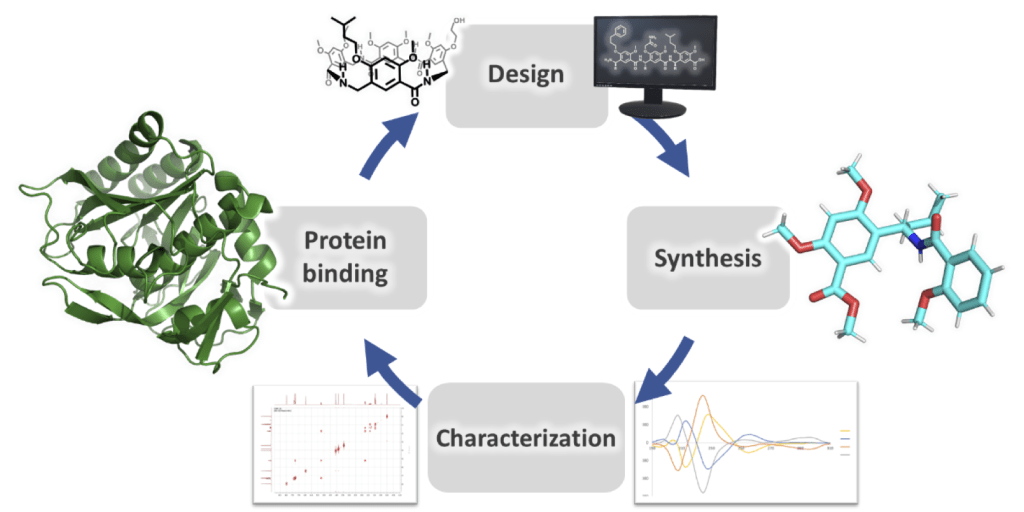
Small molecule drugs typically interact with proteins by binding in deep hydrophobic cavities called pockets. However, not all proteins contain pockets that are well-suited for drug binding. Such pocketless proteins are often called ‘undruggable’ and require alternative strategies to target them for biomedical purposes. In this project, we will be designing molecules that bind to protein surfaces rather than pockets. To accomplish this, we will create molecular scaffolds using biomimetic building blocks such as 2,4-dialkoxy-meta-aminomethylbenzoic acid (MAMBA), which can be assembled through peptide coupling reactions. The REU participant will design and synthesize a small library of scaffolds using solid-phase peptide synthesis methods. The scaffold structure will be characterized by nuclear magnetic resonance and circular dichroism spectroscopy techniques. Scaffolds will be screened for protein binding using differential scanning fluorimetry, and binding affinity will be determined by fluorescence polarization and isothermal titration calorimetry. Ultimately, the data obtained from this project will be used to understand structure-affinity relationships that can guide the design of next-generation scaffolds for protein surface recognition.
- Meisel, J. W.; Hu, C. T.; Hamilton, A. D. Mimicry of a β-Hairpin Turn by a Nonpeptidic Laterally Flexible Foldamer. Org. Lett. 2018, 20 (13), 3879–3882 https://pubs.acs.org/doi/abs/10.1021/acs.orglett.8b01463
- Meisel, J. W.; Hu, C. T.; Hamilton, A. D. Heterofunctionalized Cavitands by Macrocyclization of Sequence-Defined Foldamers. Org. Lett. 2019, 21 (19), 7762–7767 https://pubs.acs.org/doi/full/10.1021/acs.orglett.9b02708

